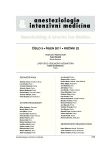Ultrasound guided medial cervical plexus blockade
Authors:
Nalos Daniel 1; Humhej Ivan 2
Authors‘ workplace:
ARO Masarykova nemocnice v Ústí nad Labem, Krajská zdravotní, a. s.
1; Neurochirurgická klinika, UJEP, Masarykova nemocnice v Ústí nad Labem, Krajská zdravotní, a. s.
2
Published in:
Anest. intenziv. Med., 22, 2011, č. 5, s. 249-252
Category:
Anaesthesiology - Original Paper
Overview
Objective:
To assess the reliability and safety of ultrasound guided medial cervical plexus blockade.
Design:
Prospective observational study.
Setting:
Department of Anesthesiology and Critical Care, Regional Tertiary Hospital.
Materials and methods:
We studied 50 ASA II-III patients (28 males and 22 females, average age 62 years) undergoing carotid endarterectomy. Medial cervical plexus blockade was performed under ultrasound guidance using „in plane“ technique. We injected 20 mL of 0.375% bupivacaine in between the fasciae dividing the sternocleidomastoid and levator scapulae muscles. All patients received 100 mcg of intravenous fentanyl after block administration. We documented the incidence of satisfactory blockade for carotid artery surgery, the need for supplementary infiltrative local anaesthesia with 1% trimecaine, the need for conversion to general anaesthesia and the complication rate.
Results:
Medial cervical block without any supplementary local anaesthesia was achieved in 32 (64%) patients. Supplementary infiltration of local anaesthetic into the operative area was required in 17 (34%) patients. Only one patient required repeated local anaesthetic supplementation.
Conclusion:
Conversion to general anaesthesia was not necessary in any of our patients. The following complications were encountered: transient unilateral recurrent nerve block in two patients and transient phrenic nerve block in one case.
Keywords:
regional anaesthesia – ultrasound – cervical block
Sources
1. Pandit, J. J. et al. Superficial or deep cervical plexu block for carotid endarterectomy. Systemic review of complications. Br. J. Anesth., 2007, 99, p. 159–169.
2. Horáček, M. Povrchový cervikální blok pro operaci krčních tepen. Sborník XVI. kongresu ČSARIM, 2009. Regionální anestézie I., Předn. č. 3. Dostupné na www: www.csarim.cz.
3. Nalos, D. et al. Superficial and interfascial cervical block – MRI study. Anest. intenziv. Med., 2011, 22, 4, s. 215–218.
4. Zhang, M. et al. The investing layer of deep cervical fascia does not exit between the sternocleidomastoid and trapezius muscles. Otolaryngol. Head Neck Surg., 2002, 127, p. 452–454.
5. Pandit, J. J. et al. Spread of injectate with superficial cervical plexus block in humans: an anatomical study. Br. J. Anaesth., 2003, 91, p. 733–735.
6. Nalos, D. et al. Fascie brachiálního plexu. Anest. intenziv. Med., 2010, 21, 4, p. 185–190.
7. Winnie, A. P. et al. Interscalene Cervical Plexus Block A Single-Injection Technique. Anesth. Analg., 1975, 54, p. 370–375.
8. Dhonneur, G. et al. Demonstration of the Spread of Injectate With Deep Cervical Plexus Block: A Case Series. Reg. Anesth. Pain Med., 2007, 32, p. 116–119.
9. Casutt, M. et al. Intermediate cervical Plexus Block for Karotid Endarterectomy: Case Series of the Spread of Injectate. J. Anesth. Clinic Res., 2011, 2, p. 2.
10. Hakl, M. et al. Regional anaesthesia for carotid endarterectomy: an audit over 10 years. Br. J. Anaesth., 2007, 99, 3, p. 415–420.
Labels
Anaesthesiology, Resuscitation and Inten Intensive Care MedicineArticle was published in
Anaesthesiology and Intensive Care Medicine

2011 Issue 5
Most read in this issue
- Ultrasound guided medial cervical plexus blockade
- Does measuring the intracranial pressure influence survival rates in patients with brain injury?
- The mechanism of hypotension with intravenous paracetamol in the critically ill
- Fibrinolysis in cardiac surgery in the post-aprotinin era
